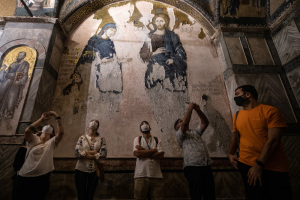Bible Answer Man Discusses New Book 'The Last Temple': 666, the Beast, and the End Times
Hank Hanegraaff, known as the Bible Answer Man, released a new fictional book over the summer titled The Last Temple, which deals with the prophecies found in the book of Revelation. Hanegraaff is the president of the apologetics ministry The Christian Research Institute that deals with defending Christianity and many of the popular topics within the faith on the Bible Answer Man radio broadcast.
Hanegraaff co-authored The Last Temple with fiction writer Sigmund Brouwer, and holds a view on the great tribulation and the beast found in the book of Revelation- his view greatly differs from many of today's prominent evangelical leaders. Renowned names such as John Hagee, David Jeremiah, Tim LaHaye, and Hal Lindsey believe the tribulation is yet to come, and that viewpoint has been chronicled in fictional Christian works like the Left Behind series. Hanegraaff, though, thinks the tribulation took place during the first century A.D. and will not occur in the 21st century.
The Bible Answer Man still holds to essential Christian doctrine, however, especially with regards to the second coming of Christ. Hanegraaff thinks the Messiah's reign will begin sometime in the future, but that the time of his return cannot be predicted by any series of world events. His views are expressed in The Last Temple, which follows fictional and historical people living at the time where the apostle John has just completed Revelation. In Hanegraaff's book, the preacher's vision has been delivered to many members of the early church to warn them of this great tribulation that will soon come to pass.
The Last Temple is set in Rome in the first century during the rule of Nero where believers in Jesus Christ are living under immense persecution. The story follows Gallus Sergius Vitas, a former Roman general and member of Nero's inner circle. Vitas has been sold into slavery after crossing the emperor to defend the honor of his wife Sophia, who became a believer in Christ shortly before her death. The Last Temple is the third book in a trilogy that also contains The Last Disciple and The Last Sacrifice, and its story concludes with the destruction of the Jewish Temple in Jerusalem. Hanegraaff recently discussed The Last Temple and his views on end times prophecy found in the book of Revelation with The Christian Post in an exclusive interview.
CP: What gave you the idea to write The Last Temple?
Hanegraaff: What I was doing is attempting to use the power of story to communicate the logical truth propositions that are part and parcel with my non-fiction book The Apocalypse Code. You have a subtitle to The Apocalypse Code [which says] find out what the Bible really says about the end times and why it matters today. So I'm attempting to use fiction with the power of story so people can understand what happened with respect to the destruction of the Temple in Jerusalem during the first century, and the impact that it has on reading the Bible for [all] it's worth.
CP: What kind of research goes into creating a book such as The Last Temple that takes place in the first century A.D. during the rule of Nero in the Roman Empire?
Hanegraaff: It takes a tremendous amount of research. The building blocks of the book are rooted in history and biblical truth. So they correspond to reality when it comes to both history [and biblical truth]. The mortar holding the building blocks together of course is fiction. But you can be certain that what is being described is historically accurate and biblically accurate.
CP: What are your views on end times prophecy and the book of Revelation, and how they are expressed in The Last Temple?
H: This is the revelation of Jesus Christ which God gave him to show his servants what must soon take place. So at the very beginning, Revelation is communicating that what is about to happen is near, and that the time is not far off. So these are seven letters to churches in the epicenter of a Caesar cult who are being instructed to be faithful and fruitful. They are going to suffer for a short time. Their vindication is an eternal vindication. So while the Book of Revelation was written for us, it was not written to us. It was written to churches in the epicenter of a Caesar cult. They are going to suffer the mother of all tribulations, and again they were being encouraged to have an eternal perspective ...
When you get to the end of the book of Revelation you see that revelation not only deals with that which is going to happen in the fore-future, but also with that which will happen in the final future. For example: if you look at Revelation chapter 21, you have a depiction of the eternal state where God himself lives with us, we will be his people, he will be our God and there will be no more death, mourning, crying, or pain. For the old Earth things have passed away, behold all things have become new.
CP: What is the significance of the number 666 in the book of Revelation and how do you describe it in The Last Temple?
H: Remember that Revelation is communicating the words of [the apostle] John to people in the first century and saying overtly that with wisdom and understanding they could discern the number of the beast, and the number of his name. Now, obviously, only a first century audience could understand the number of the beast and the number of his name. John is not suggesting to a first century audience that he's talking to a 21st century audience. [It is very clear] when you read this that John is attempting to say that his audience, a first century audience, with wisdom and understanding can discern the number and the name of the beast of Revelation- a beast who is seeking to wipe out a fledgling Christian church, which, by the way, this is the only time [in history] in which the church is gathered in a controllable area where they literally can be wiped out.
CP: Are you saying 666 does not apply to a beast in modern times, but to a beast that could only live during the first century A.D.?
H: Yes. ... John, who of course is the author or Revelation, is telling a first century audience that with wisdom they would be able to calculate the number of the beast because it's man's number. His number is six hundred sixty and six, it is not three consecutive 6s. That comes from Revelation 13. But, my point is, obviously no amount of wisdom and insight would have enabled a first century audience to calculate the number of a 21st century beast. And therefore it would have been cruel and dangerously misleading for John to suggest that first century Christians would be able to identify the beast if in fact the beast was a 21st century individual or institution.
CP: How do you feel about other works of Christian fiction such as the Left Behind series which also deal with the book of Revelation, but interprets it in a different way?
H: I think that ultimately, the timing of the tribulation or the meaning of the millennium is a secondary issue that we could debate vigorously, but we ultimately don't have to divide over it. But, having said that, the reality that it's a secondary issue is in no way suggesting that it is an insignificant issue because we are talking about learning to mine the Bible for all its wealth and reading the Bible for all of its worth.
Now, you just asked me a quick question about the beast of Revelation [and] if you look at the Left Behind rendering of the beast of Revelation, you have Nicolae Carpathia, who has the power to do what Jesus Christ did. He has the power not only to lay down his life, but the power to take it up again. He has the power to control Earth and sky. My question would be if that's really the case, why not worship [Carpathia]? In other words, the prerogative of resurrecting from the dead is a prerogative of Christ alone. So there are very significant issues involved.
I would also say with respect to the title of my last book The Last Temple, I think it is important to recognize that there is no need for a third or a fourth temple as depicted in the Left Behind series. Jesus Christ is the temple and we (the Church) are living stones in the temple of God. And the book of Hebrews makes clear that to have anything that supplants Jesus Christ as the temple or to fail to recognize that the temple has already come and therefore there's no longer need for temple priests and sacrifices is to trample upon the sacred blood of Jesus Christ. He is the love that fulfills temple priesthood sacrifices and therefore there is no longer any need or room for another temple.
Check out Part 2 of CP's interview with Hank Hanegraaff where he deals with Biblical illiteracy amongst Christians.




























